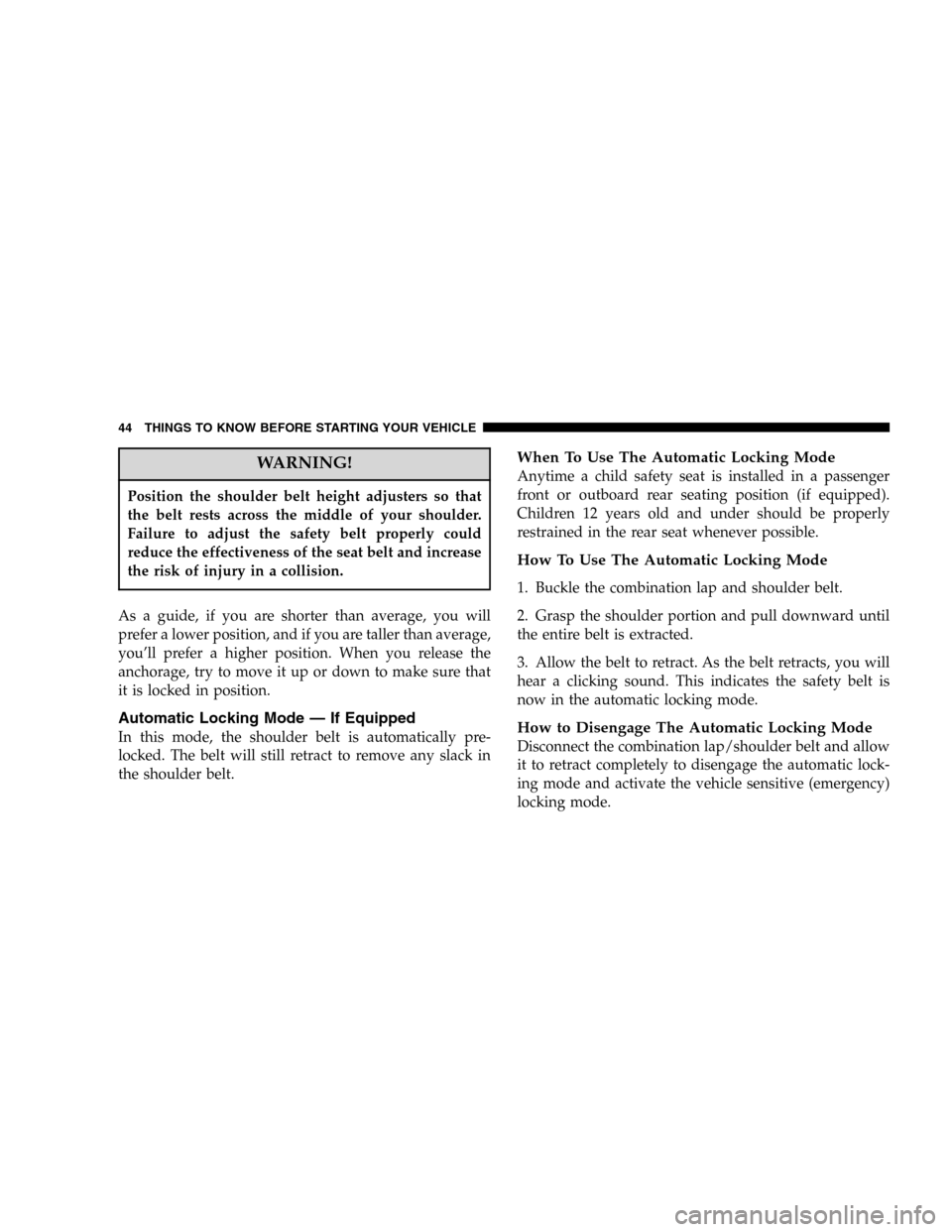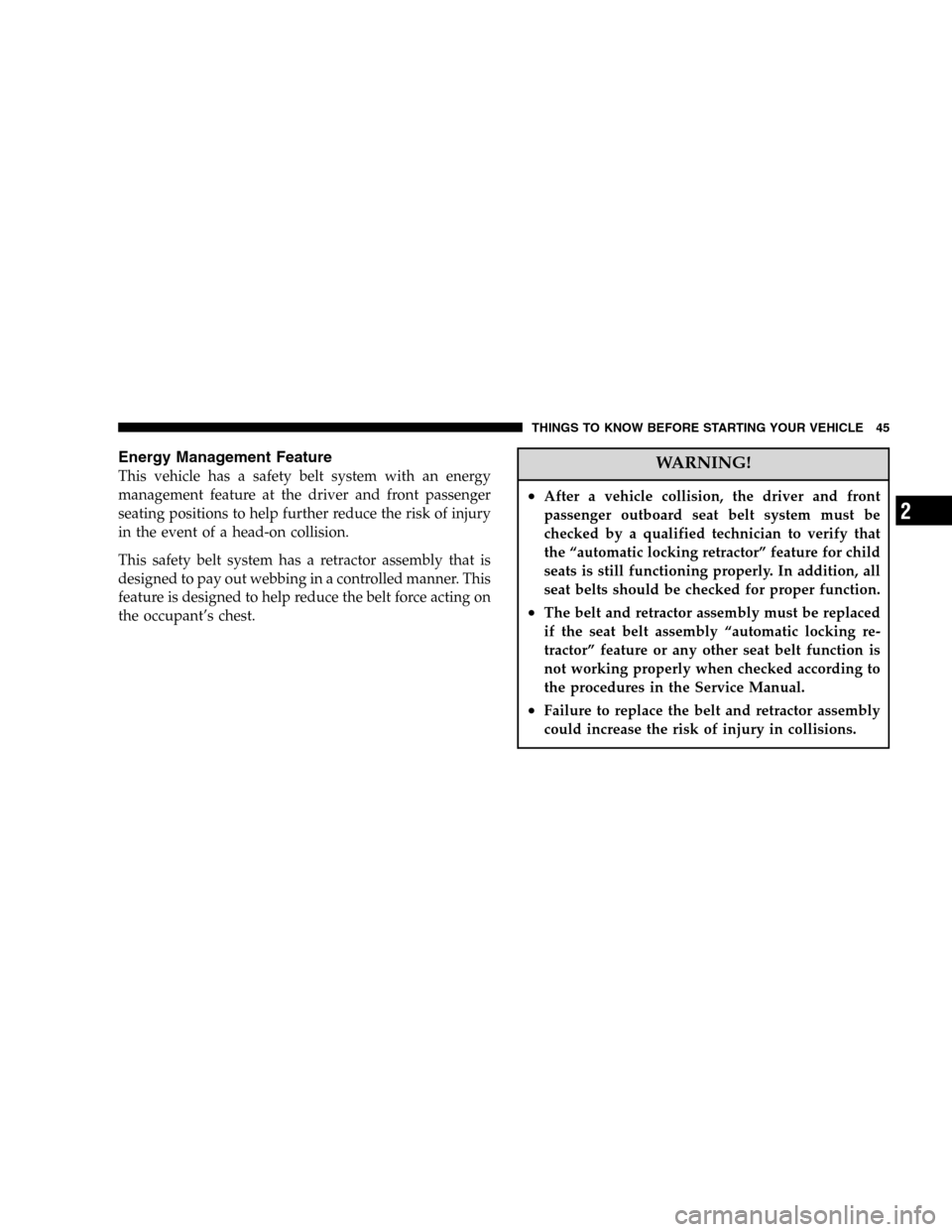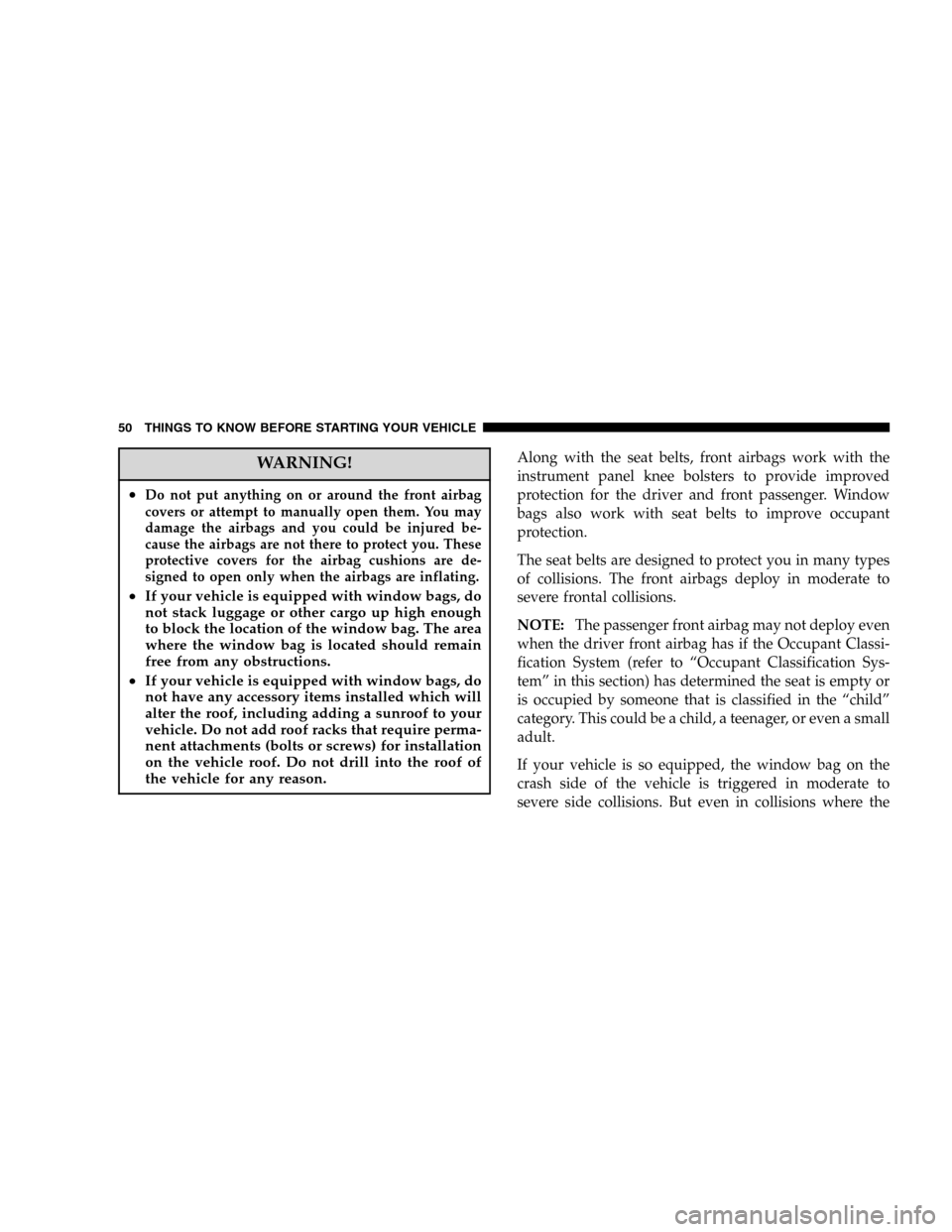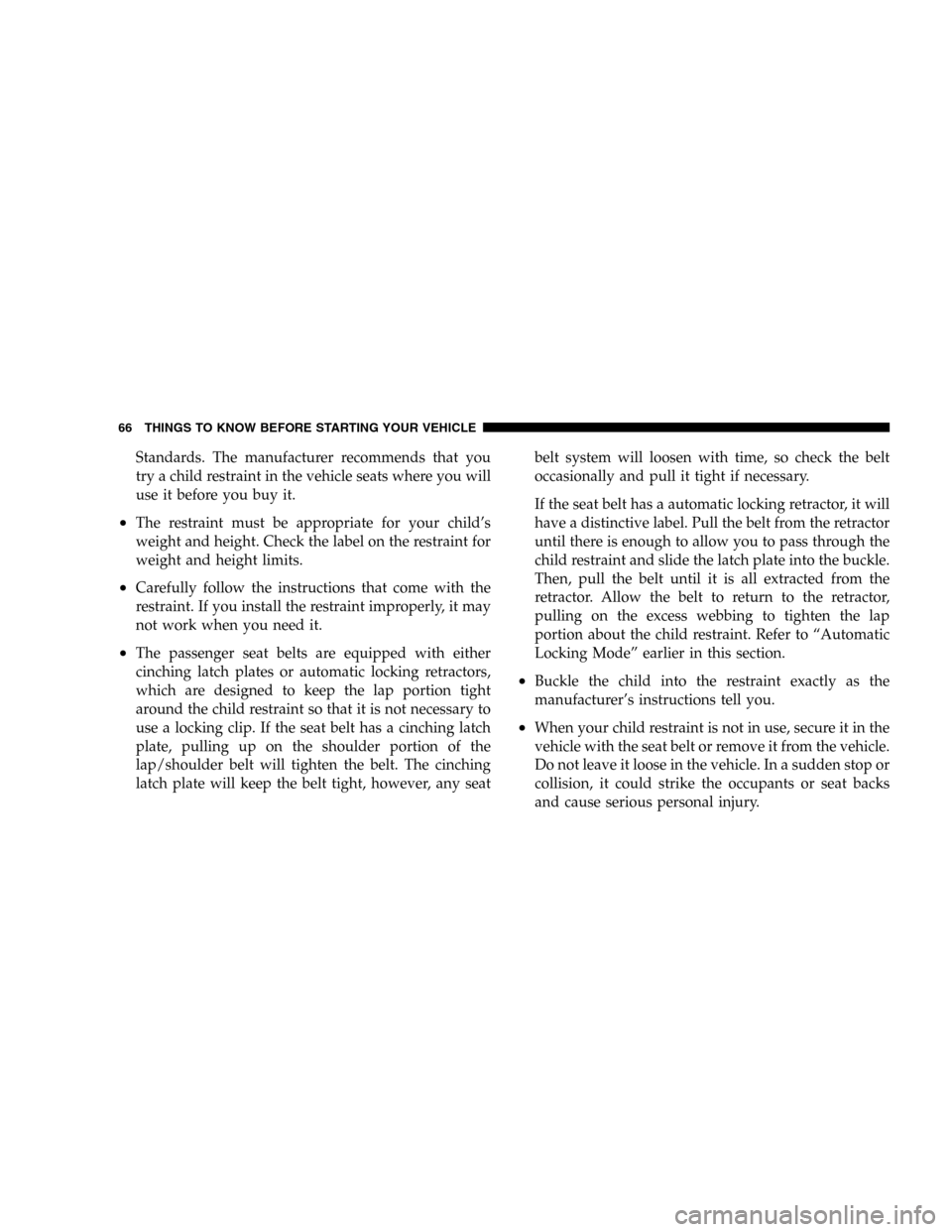Page 11 of 424
THINGS TO KNOW BEFORE STARTING YOUR VEHICLE
CONTENTS
�A Word About Your Keys..................14
▫Ignition Key..........................14
▫Key-In-Ignition Reminder................16
�Sentry Key Immobilizer System..............16
▫Important Note About Service.............17
▫Replacement Keys......................17
▫Customer Key Programming..............18
▫General Information....................18
�Steering Wheel Lock — If Equipped..........19▫To Manually Lock The Steering Wheel.......19
▫To Release The Steering Wheel Lock.........19
�Illuminated Entry........................19
�Doors And Door Locks....................20
▫Manual Door Locks.....................21
▫Power Door Locks — If Equipped..........23
▫Automatic Door Locks — If Equipped.......23
▫Child Protection Locks..................24
�Remote Keyless Entry.....................25
2
Page 15 of 424
To remove the ignition key on models with a manual
transmission, depress and hold the key release button,
turn the ignition key to LOCK and remove the key.WARNING!
Leaving children in a vehicle unattended is danger-
ous for a number of reasons. A child or others could
be injured. Children should be warned not to touch
the parking brake, brake pedal, or the gear selector
lever. Do not leave the keys in the ignition. A child
could operate power windows, other controls, or
move the vehicle.
CAUTION!
An unlocked vehicle is an invitation to thieves.
Always remove the key from the ignition, and lock
all doors when leaving the vehicle unattended.
Ignition Key Release Button
THINGS TO KNOW BEFORE STARTING YOUR VEHICLE 15
2
Page 22 of 424
WARNING!
•For personal security, and safety in the event of an
accident, lock the vehicle doors as you drive as
well as when you park and leave the vehicle.
•When leaving the vehicle always remove the key
from the ignition lock, and lock your vehicle. Do
not leave children unattended in the vehicle, or
with access to an unlocked vehicle. Unsupervised
use of vehicle equipment may cause severe per-
sonal injuries and death.
CAUTION!
An unlocked vehicle is an invitation to thieves.
Always remove the key from the ignition and lock
all of the doors when leaving the vehicle unattended.
22 THINGS TO KNOW BEFORE STARTING YOUR VEHICLE
Page 24 of 424
Child Protection Locks
The rear doors of your vehicle are equipped with child
protection locks. If you push up on the lever on the open
edge of the door it cannot be opened from the inside of
the vehicle. Push the lever down to disengage the child
protection locks.
WARNING!
Avoid trapping anyone in the vehicle in a collision.
Remember that the rear doors can only be opened
from the outside when the child protection locks are
engaged.
Child Lock Control
24 THINGS TO KNOW BEFORE STARTING YOUR VEHICLE
Page 44 of 424

WARNING!
Position the shoulder belt height adjusters so that
the belt rests across the middle of your shoulder.
Failure to adjust the safety belt properly could
reduce the effectiveness of the seat belt and increase
the risk of injury in a collision.
As a guide, if you are shorter than average, you will
prefer a lower position, and if you are taller than average,
you’ll prefer a higher position. When you release the
anchorage, try to move it up or down to make sure that
it is locked in position.
Automatic Locking Mode — If Equipped
In this mode, the shoulder belt is automatically pre-
locked. The belt will still retract to remove any slack in
the shoulder belt.
When To Use The Automatic Locking Mode
Anytime a child safety seat is installed in a passenger
front or outboard rear seating position (if equipped).
Children 12 years old and under should be properly
restrained in the rear seat whenever possible.
How To Use The Automatic Locking Mode
1. Buckle the combination lap and shoulder belt.
2. Grasp the shoulder portion and pull downward until
the entire belt is extracted.
3. Allow the belt to retract. As the belt retracts, you will
hear a clicking sound. This indicates the safety belt is
now in the automatic locking mode.
How to Disengage The Automatic Locking Mode
Disconnect the combination lap/shoulder belt and allow
it to retract completely to disengage the automatic lock-
ing mode and activate the vehicle sensitive (emergency)
locking mode.
44 THINGS TO KNOW BEFORE STARTING YOUR VEHICLE
Page 45 of 424

Energy Management Feature
This vehicle has a safety belt system with an energy
management feature at the driver and front passenger
seating positions to help further reduce the risk of injury
in the event of a head-on collision.
This safety belt system has a retractor assembly that is
designed to pay out webbing in a controlled manner. This
feature is designed to help reduce the belt force acting on
the occupant’s chest.WARNING!
•After a vehicle collision, the driver and front
passenger outboard seat belt system must be
checked by a qualified technician to verify that
the “automatic locking retractor” feature for child
seats is still functioning properly. In addition, all
seat belts should be checked for proper function.
•The belt and retractor assembly must be replaced
if the seat belt assembly “automatic locking re-
tractor” feature or any other seat belt function is
not working properly when checked according to
the procedures in the Service Manual.
•Failure to replace the belt and retractor assembly
could increase the risk of injury in collisions.
THINGS TO KNOW BEFORE STARTING YOUR VEHICLE 45
2
Page 50 of 424

WARNING!
•Do not put anything on or around the front airbag
covers or attempt to manually open them. You may
damage the airbags and you could be injured be-
cause the airbags are not there to protect you. These
protective covers for the airbag cushions are de-
signed to open only when the airbags are inflating.
•If your vehicle is equipped with window bags, do
not stack luggage or other cargo up high enough
to block the location of the window bag. The area
where the window bag is located should remain
free from any obstructions.
•If your vehicle is equipped with window bags, do
not have any accessory items installed which will
alter the roof, including adding a sunroof to your
vehicle. Do not add roof racks that require perma-
nent attachments (bolts or screws) for installation
on the vehicle roof. Do not drill into the roof of
the vehicle for any reason.
Along with the seat belts, front airbags work with the
instrument panel knee bolsters to provide improved
protection for the driver and front passenger. Window
bags also work with seat belts to improve occupant
protection.
The seat belts are designed to protect you in many types
of collisions. The front airbags deploy in moderate to
severe frontal collisions.
NOTE:The passenger front airbag may not deploy even
when the driver front airbag has if the Occupant Classi-
fication System (refer to “Occupant Classification Sys-
tem” in this section) has determined the seat is empty or
is occupied by someone that is classified in the “child”
category. This could be a child, a teenager, or even a small
adult.
If your vehicle is so equipped, the window bag on the
crash side of the vehicle is triggered in moderate to
severe side collisions. But even in collisions where the
50 THINGS TO KNOW BEFORE STARTING YOUR VEHICLE
Page 66 of 424

Standards. The manufacturer recommends that you
try a child restraint in the vehicle seats where you will
use it before you buy it.
•The restraint must be appropriate for your child’s
weight and height. Check the label on the restraint for
weight and height limits.
•Carefully follow the instructions that come with the
restraint. If you install the restraint improperly, it may
not work when you need it.
•The passenger seat belts are equipped with either
cinching latch plates or automatic locking retractors,
which are designed to keep the lap portion tight
around the child restraint so that it is not necessary to
use a locking clip. If the seat belt has a cinching latch
plate, pulling up on the shoulder portion of the
lap/shoulder belt will tighten the belt. The cinching
latch plate will keep the belt tight, however, any seatbelt system will loosen with time, so check the belt
occasionally and pull it tight if necessary.
If the seat belt has a automatic locking retractor, it will
have a distinctive label. Pull the belt from the retractor
until there is enough to allow you to pass through the
child restraint and slide the latch plate into the buckle.
Then, pull the belt until it is all extracted from the
retractor. Allow the belt to return to the retractor,
pulling on the excess webbing to tighten the lap
portion about the child restraint. Refer to “Automatic
Locking Mode” earlier in this section.
•Buckle the child into the restraint exactly as the
manufacturer’s instructions tell you.
•When your child restraint is not in use, secure it in the
vehicle with the seat belt or remove it from the vehicle.
Do not leave it loose in the vehicle. In a sudden stop or
collision, it could strike the occupants or seat backs
and cause serious personal injury.
66 THINGS TO KNOW BEFORE STARTING YOUR VEHICLE